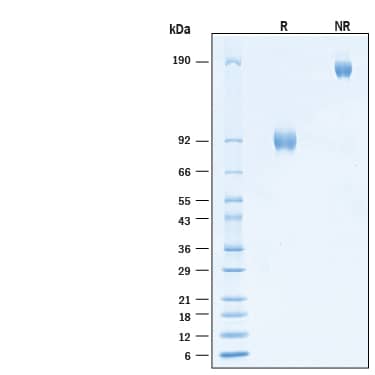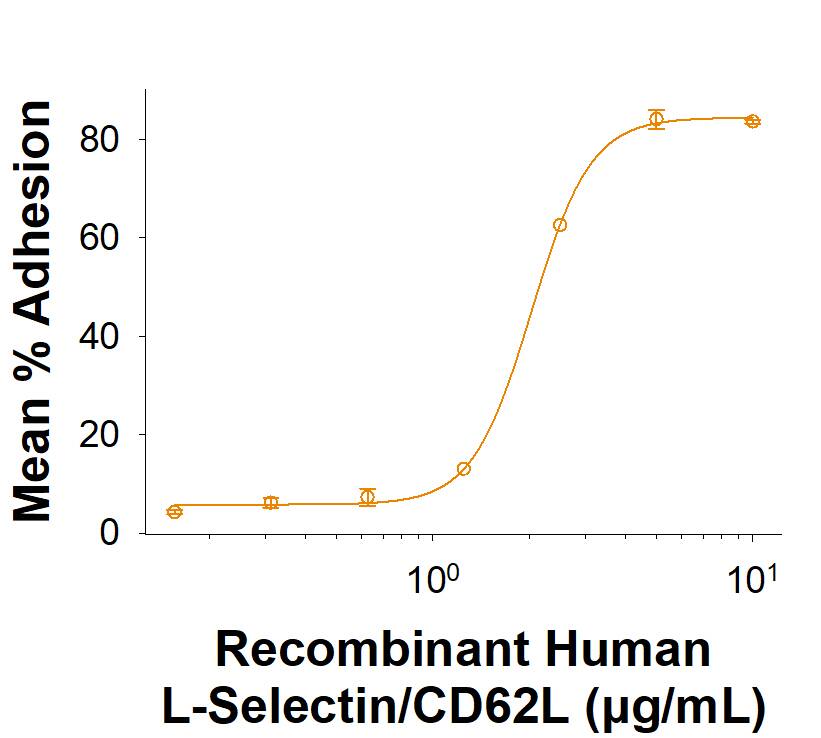Recombinant Human L-Selectin/CD62L Fc Chimera Protein, CF
R&D Systems, part of Bio-Techne | Catalog # 11169-LS

Key Product Details
Source
CHO
Accession #
Structure / Form
Disulfide-linked homodimer
Conjugate
Unconjugated
Applications
Bioactivity
Product Specifications
Source
Chinese Hamster Ovary cell line, CHO-derived human L-Selectin/CD62L protein
| Human L-Selectin (Trp52-Leu332) Accession # AAH20758.1 |
IEGRMD | Human IgG1 (Pro100-Lys330) |
| N-terminus | C-terminus |
Purity
>95%, by SDS-PAGE visualized with Silver Staining and quantitative densitometry by Coomassie® Blue Staining.
Endotoxin Level
<0.10 EU per 1 μg of the protein by the LAL method.
N-terminal Sequence Analysis
Trp52
Predicted Molecular Mass
58 kDa
SDS-PAGE
85-100 kDa, under reducing conditions.
Activity
Measured by the ability of the immobilized protein to support the adhesion of LS180 human colorectal adenocarcinoma cells.
The ED50 for this effect is 0.350-3.50 μg/mL.
The ED50 for this effect is 0.350-3.50 μg/mL.
Scientific Data Images for Recombinant Human L-Selectin/CD62L Fc Chimera Protein, CF
Recombinant Human L‑Selectin/CD62L Fc Chimera Protein Bioactivity.
Recombinant Human L‑Selectin/CD62L Fc Chimera Protein (Catalog # 11169-LS) supports the adhesion LS180 human colorectal adenocarcinoma cells. The ED50 for this effect is 0.350-3.50 μg/mL.Recombinant Human L‑Selectin/CD62L Fc Chimera Protein SDS-PAGE.
2 μg/lane of Recombinant Human L‑Selectin/CD62L Fc Chimera Protein (Catalog # 11169-LS) was resolved with SDS-PAGE under reducing (R) and non-reducing (NR) conditions and visualized by Coomassie® Blue staining, showing bands at 85-100 kDa and 170-200 kDa, respectively.Formulation, Preparation and Storage
11169-LS
| Formulation | Supplied as a 0.2 μm filtered solution in PBS with Trehalose. |
| Shipping | The product is shipped with dry ice or equivalent. Upon receipt, store it immediately at the temperature recommended below. |
| Stability & Storage | Use a manual defrost freezer and avoid repeated freeze-thaw cycles.
|
Background: L-Selectin/CD62L
References
- Ivetic, A. et al. (2019) Front. Immunol. 10:1068.
- Grailer, J.J. et al. (2009) J. Dermatol sci. 56:141.
- Hirata, T. et al. (2015) Biochem Biophys Res. Commun. 462:371.
- Wedepohl, S. et al. (2012) Euro. J. Cell Biol. 91:257.
- Ivetic, A. et al. (2013) Inter. J. Biochem. Cell Biol. 45:550.
- Granger, D.N. and Senchenkova, E. (2010) Inflammation and the Microcirculation. San Rafael (CA): Morgan & Claypool Life Sciences Chapter 7.
- Watson, H.A. et al. (2019) Frontiers in immunology 10:1321.
Alternate Names
CD62L, hLHRc, LAM1, LECAM1, Leu-8, LNHR, LSEL, Lyam-1, LYAM1, PLNHR, SELL, TQ1
Gene Symbol
SELL
UniProt
Additional L-Selectin/CD62L Products
Product Documents for Recombinant Human L-Selectin/CD62L Fc Chimera Protein, CF
Product Specific Notices for Recombinant Human L-Selectin/CD62L Fc Chimera Protein, CF
For research use only
